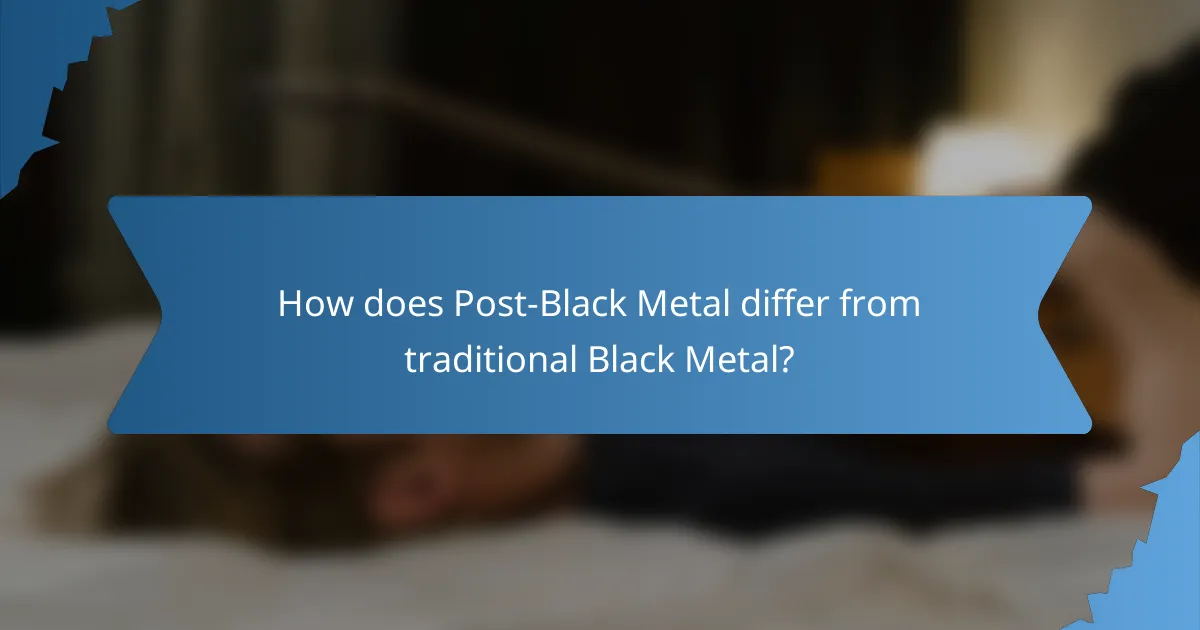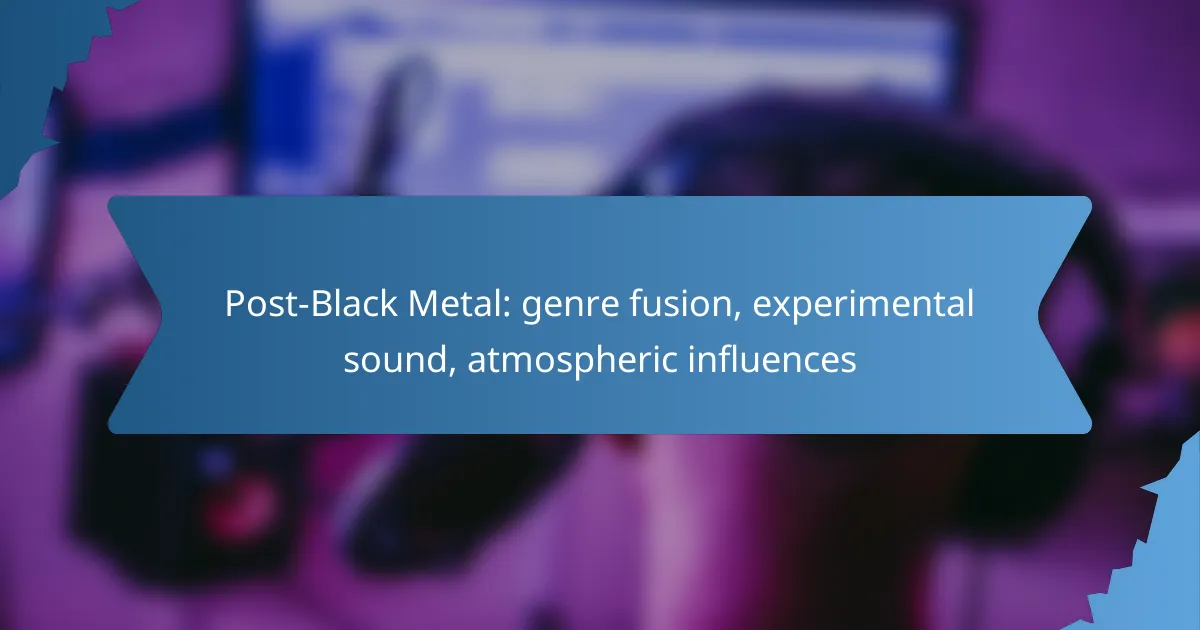Post-Black Metal is a genre that merges traditional black metal with diverse musical influences, creating a rich, experimental, and atmospheric sound. This style emphasizes emotional depth and sonic exploration, pushing the boundaries of classic black metal. Notable bands like Alcest, Les Discrets, and Deafheaven have significantly shaped the genre, infusing it with unique elements that enhance its appeal and complexity.

How is Post-Black Metal defined?
Post-Black Metal is a genre that blends traditional black metal elements with influences from various other musical styles, resulting in a more experimental and atmospheric sound. It often emphasizes emotional depth and sonic exploration, moving beyond the confines of classic black metal.
Fusion of Black Metal and other genres
Post-Black Metal incorporates elements from genres such as shoegaze, post-rock, and even ambient music. This fusion allows for a diverse range of sounds, where harsh vocals and blast beats coexist with melodic guitar lines and ethereal soundscapes.
For example, bands like Alcest and Les Discrets exemplify this blend, using clean vocals and lush instrumentation alongside traditional black metal techniques. This genre fusion creates a unique listening experience that appeals to a broader audience.
Characteristics of experimental sound
The experimental sound in Post-Black Metal is marked by unconventional song structures, varied tempos, and the use of non-traditional instruments. Artists often explore different sonic textures, creating a rich auditory landscape that can evoke a wide range of emotions.
Many bands experiment with layering and effects, such as reverb and delay, to enhance their sound. This experimentation can lead to tracks that vary significantly in length, often exceeding the typical duration found in traditional black metal.
Atmospheric influences in the genre
Atmospheric influences play a crucial role in Post-Black Metal, as the genre often aims to create immersive soundscapes. This is achieved through the use of ambient sounds, field recordings, and extended instrumental passages that invite listeners into a specific mood or setting.
For instance, the incorporation of nature sounds or cinematic elements can transport listeners to different environments, enhancing the overall experience. This atmospheric quality is a defining feature that distinguishes Post-Black Metal from its predecessors, making it a compelling genre for those seeking depth and nuance in music.

What are the key bands in Post-Black Metal?
Key bands in Post-Black Metal include Alcest, Les Discrets, and Deafheaven, each contributing unique elements that define the genre. Their innovative fusions of black metal with atmospheric and experimental sounds have broadened the genre’s appeal and depth.
Alcest as a pioneer
Alcest is often credited as a pioneer of Post-Black Metal, blending traditional black metal with shoegaze and ambient influences. Their debut album, “Souvenirs d’un autre monde,” introduced ethereal melodies and clean vocals, creating a dreamlike atmosphere that contrasts sharply with the harshness of black metal.
This fusion has inspired countless bands, encouraging a movement that embraces emotional expression and sonic exploration. Alcest’s work exemplifies how Post-Black Metal can evoke deep feelings while maintaining the intensity of its roots.
Les Discrets’ unique sound
Les Discrets offers a unique sound that combines elements of Post-Black Metal with folk and post-rock influences. Their music features intricate guitar work and atmospheric soundscapes, often accompanied by poetic lyrics that explore themes of nature and introspection.
Albums like “Ariettes Oubliées…” showcase their ability to create immersive experiences, drawing listeners into a world that feels both haunting and serene. This distinctive approach has garnered them a dedicated following and solidified their place within the genre.
Deafheaven’s impact on the genre
Deafheaven has made a significant impact on Post-Black Metal by incorporating elements of shoegaze, post-rock, and even blackgaze into their sound. Their breakthrough album, “Sunbather,” features a blend of blistering guitar riffs and melodic passages, appealing to both metal enthusiasts and a broader audience.
Their success has opened doors for other bands to experiment with genre boundaries, encouraging a more diverse range of sounds within Post-Black Metal. Deafheaven’s ability to merge intensity with beauty has redefined expectations and expanded the genre’s reach in contemporary music.

What are the common themes in Post-Black Metal lyrics?
Post-Black Metal lyrics often explore deep and complex themes, reflecting a blend of personal and universal experiences. Common themes include existentialism, nature, and emotional struggles, which are articulated through atmospheric and experimental soundscapes.
Existentialism and introspection
Existentialism is a prevalent theme in Post-Black Metal, where lyrics delve into the nature of existence and the search for meaning. Artists often express feelings of alienation and the quest for identity, prompting listeners to reflect on their own lives.
This introspective approach can manifest in abstract imagery and philosophical questions, encouraging a deep emotional connection. For example, lyrics may ponder the futility of life or the inevitability of death, resonating with those grappling with similar thoughts.
Nature and environment
Nature serves as a powerful backdrop in Post-Black Metal lyrics, often symbolizing both beauty and despair. Many bands draw inspiration from landscapes, using vivid descriptions of forests, mountains, and the elements to evoke a sense of place and mood.
This connection to the environment can reflect themes of decay and renewal, highlighting humanity’s impact on nature. Lyrics may explore the juxtaposition of serene natural beauty against the harsh realities of modern life, creating a poignant commentary on ecological issues.
Emotional experiences and struggles
Emotional experiences are central to Post-Black Metal, with lyrics frequently addressing personal struggles such as grief, loss, and mental health. The raw expression of these feelings allows listeners to find solace and understanding in shared experiences.
Artists often use metaphor and vivid storytelling to convey their emotional journeys, making the music relatable. This focus on vulnerability can foster a sense of community among fans, as they connect over similar hardships and triumphs.

How does Post-Black Metal differ from traditional Black Metal?
Post-Black Metal diverges from traditional Black Metal by incorporating a broader range of musical influences, emphasizing atmosphere and melody over the raw aggression typical of its predecessor. This genre fusion results in a more experimental sound that often includes elements from post-rock, shoegaze, and ambient music.
Incorporation of melodic elements
Post-Black Metal frequently integrates melodic elements that soften the harshness of traditional Black Metal. This can manifest through intricate guitar harmonies, lush keyboard arrangements, and atmospheric soundscapes that create a more immersive listening experience. Bands like Alcest and Les Discrets exemplify this trend by blending melodic lines with heavier riffs.
The use of melody can enhance emotional depth, allowing for a more nuanced expression of themes such as nature, introspection, and existentialism. This shift towards melody often appeals to a wider audience, bridging the gap between metal and other genres.
Use of clean vocals
Clean vocals are a hallmark of Post-Black Metal, contrasting sharply with the harsh, guttural screams of traditional Black Metal. This stylistic choice allows for a greater range of lyrical expression and emotional conveyance. Many bands utilize clean singing to evoke feelings of serenity or melancholy, further enriching the atmospheric quality of their music.
Incorporating clean vocals can attract listeners who may be put off by the aggressive vocal styles of traditional Black Metal. This accessibility can help expand the genre’s fan base while maintaining its core elements.
Varied song structures
Post-Black Metal often features varied song structures that deviate from the typical verse-chorus format found in traditional Black Metal. Songs may include extended instrumental passages, dynamic shifts, and unconventional arrangements, allowing for a more exploratory approach to songwriting. This flexibility enables artists to experiment with pacing and mood, creating a more engaging listening experience.
For example, tracks may blend long, atmospheric intros with sudden bursts of intensity, or seamlessly transition between different musical styles within a single piece. This experimentation encourages creativity and can lead to innovative compositions that challenge genre boundaries.

What are the production techniques in Post-Black Metal?
Post-Black Metal employs a variety of production techniques that enhance its atmospheric and experimental sound. These methods include layered instrumentation, ambient soundscapes, and innovative recording practices that contribute to the genre’s unique sonic identity.
Layered instrumentation
Layered instrumentation is a hallmark of Post-Black Metal, where multiple musical elements are combined to create a rich, textured sound. This often involves the use of guitars, keyboards, and strings, each playing distinct yet complementary parts. The goal is to build a complex auditory landscape that immerses the listener.
Producers often experiment with different guitar tunings and effects to achieve a more expansive sound. For instance, using reverb and delay can help create a sense of depth, while harmonizing guitar lines can add emotional weight to the music.
Use of ambient soundscapes
Ambient soundscapes play a crucial role in Post-Black Metal, providing a backdrop that enhances the emotional and atmospheric qualities of the music. These soundscapes can include field recordings, synthesizers, and effects that evoke natural environments or abstract spaces. This approach allows for a more immersive listening experience.
Incorporating ambient elements can be done subtly, such as layering soft synth pads beneath heavier guitar riffs, or more overtly, by dedicating entire sections of a song to atmospheric sounds. This balance between heavy and light creates dynamic contrasts that keep the listener engaged.
Innovative recording methods
Innovative recording methods are essential in Post-Black Metal, as they allow artists to push the boundaries of traditional music production. Techniques such as using unconventional microphones, experimenting with live recordings, and manipulating audio in post-production can lead to unique sound outcomes. These methods often prioritize capturing the raw emotion of a performance.
For example, recording in unconventional spaces, like abandoned buildings or forests, can add an organic quality to the sound. Additionally, using software to manipulate audio can create unexpected textures and layers, further enhancing the genre’s experimental nature.

What are the emerging trends in Post-Black Metal?
Emerging trends in Post-Black Metal include a notable fusion with various musical genres, leading to innovative and experimental sounds. Artists are increasingly incorporating atmospheric influences, which enhance the emotional depth and complexity of their music.
Increased collaboration with other genres
Post-Black Metal is witnessing a significant rise in collaborations with genres such as shoegaze, post-rock, and even electronic music. This blending allows artists to explore new textures and sonic landscapes, creating a richer auditory experience.
For example, bands may incorporate lush guitar effects typical of shoegaze or the expansive soundscapes found in post-rock. This trend not only broadens the appeal of Post-Black Metal but also attracts listeners from diverse musical backgrounds.
When experimenting with genre fusion, it’s essential to maintain a balance; too much deviation from traditional black metal elements can alienate core fans. Artists should aim for a harmonious integration that respects the roots of the genre while pushing creative boundaries.
